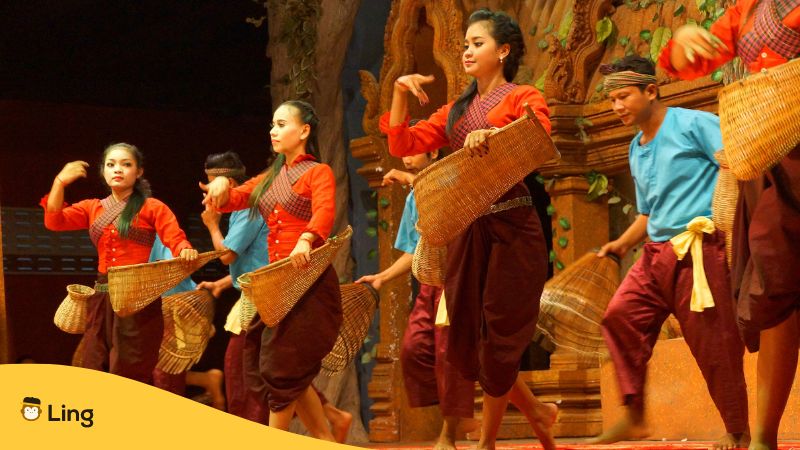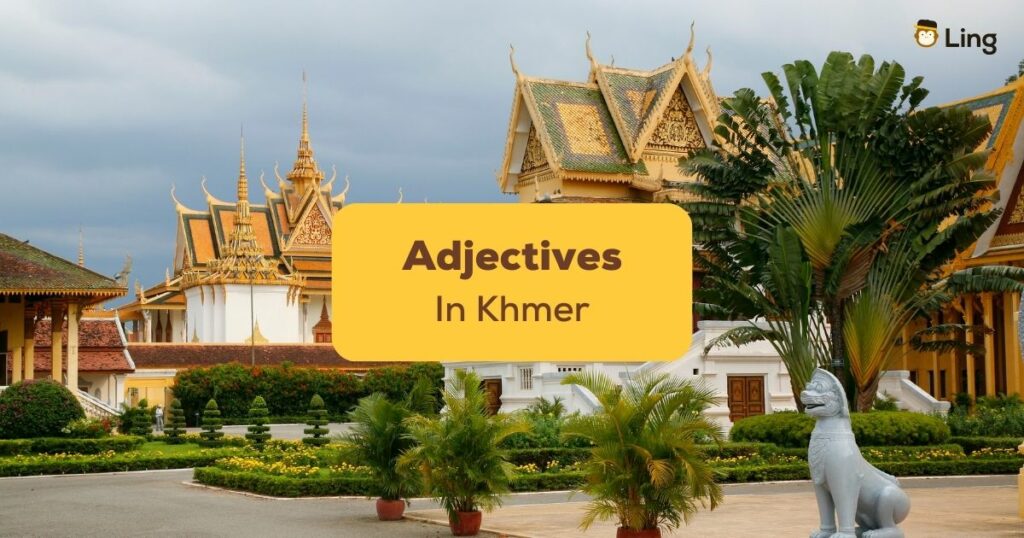Got a knack for picking up new languages, or are you simply curious about how speakers in Cambodia express themselves? Either way, you’re exactly where you’re supposed to be.
Khmer is a beautifully complex Austroasiatic language spoken enthusiastically by over 18.4 million people. Today, we put the magnifying glass on a vastly overlooked aspect of the language integral to its structure: Khmer adjectives.
Anxious about tackling adjectives in a foreign language system? Fear not! With our guide, we can confidently reassure you that Khmer adjectives will smoothly glide off your tongue as though they’ve always been a part of your everyday vocabulary.
Understanding Adjectives
Let’s get straight to the heart of our journey into Khmer—with a deep dive into adjectives. Now, don’t let the term ‘adjective’ intimidate you. In the simplest terms, ‘adjectives’ are just words we use to decorate nouns. Imagine your favorite cupcake. It’s not just any cupcake; it’s a ‘chocolate’ cupcake or maybe a ‘vanilla’ cupcake. That ‘chocolate’ or ‘vanilla’ is an adjective. Pretty straightforward, right?
Characteristics Of Khmer Adjectives
Now that we’ve broken the ice on what adjectives are, it’s time to see what makes Khmer adjectives unique. In this section, we’ll dive into the distinct characteristics of Khmer adjectives. Buckle up. It’s going to be an educational ride!
The Independent Streak
Right out of the gate, Khmer adjectives stand out due to their independent nature. Unlike its English counterparts, which rely heavily on the existence of nouns, Khmer adjectives can stand alone. They can act as the main verb in a sentence, talking about qualities or states. So a simple English sentence like, “The house is big,” translates in Khmer to, “House big,” with ‘big’ taking the Khmer verbs’ spot. A minimalist’s language dream, indeed!
Position Matters
One of the most prominent features of Khmer adjectives is their positioning. Khmer adjectives trail the nouns they describe. So, if you’re keen on describing a ‘happy dog’ in Khmer, you’d be saying ‘dog happy.’ It’s like a small procession, where the noun (the guest of honor) leads, and the adjective (the trailing fanfare) follows.
Flexibility Is Key
Lastly, Khmer adjectives aren’t sticklers for consistent form like English adjectives. In Khmer, an adjective does not change its form based on the noun’s gender, number, or case. This means less memorization and more application. It’s like having a key that can unlock any door— Khmer adjectives just fit, regardless of the situation.
If you’re more familiar with English or other languages, these characteristics might take a bit of getting used to. But remind yourself— every new language opens up a new way of seeing the world. So let’s embrace these differences and get ready to add some shine to your Khmer language skills with adjectives!

Common Khmer Adjectives
Before diving into the long list of adjectives, let’s ensure we’ve got the basics sorted out. Khmer adjectives are awesome! They are flexible and don’t require agreement on number or gender as adjectives do in some other languages. How cool is that?
Here are some examples of common Khmer adjectives with sample phrases:
| English | Khmer | Sample Phrase | Khmer Translation |
| Big | ធំ (thom) | big store | ហាងធំ (Hang thom) |
| Small | តូច (tauch) | small children | កូនតូច (Kon tauch) |
| Long | វែង (veng) | long road | ផ្លូវវែង (phlov veng) |
| Short | លី (khlei) | short sticks | ឈើខ្លី (Cheu khlei) |
| Tall | ខ្ពស់ (khpasa) | tall person | រូបខ្ពស់ (roup khpasa) |
| Thick | ក្រាស់ (krasa) | thick snout | សំពីង្គាក្រាស់ (sampy-nga krasa) |
| Thin | ស្តើង (staeng) | thin tone | សំនៀងស្តើង (Samnieng staeng) |
| Wide | ទូលាយ (touleay) | wide space | កន្លែងធំទូលាយ (kanleng thom touleay) |
| Bad | អាក្រក់ (akrak) | bad story | រឿងអាក្រក់ (reung akrak) |
| Good | ល្អ (la) | good song | ចម្រៀងល្អ។ (chamrieng la) |
| Easy | ងាយស្រួល (ngeayosruol) | easy work | ការងារងាយស្រួល (kakar ngeayosruol) |
| Difficult | ពិបាក (pibeak) | difficult problem | ចំណោទពិបាក (chamnat pibeak) |
| Expensive | ថ្លៃ (thlai) | expensive item | ទំនិញថ្លៃ (tumnit thlai) |
| Cheap | ថោក (thaok) | cheap food | អាហារថោក (ahar thaok) |
| Fast | លឿន (luen) | fast car | រថយន្តលឿន (rathy lnrt luen) |
| Slow | យឺត (yut) | slow walking | រហូតាយឺត (rahoat yut) |
| Old | ចាស់ (chasa) | old company | ក្រុមហ៊ុនចាស់ (kromhoun chasa) |
| Young | ក្មេង (kmeng) | young leader | នាយក្មេង (naiya kmeng) |
| New | ថ្មី (thmei) | new plastic | ប្លាស៊ីថ្មី (pleasii thmei) |
| Strong | ខ្លាំង (khlang) | strong punch | គ្រាប់ដៃខ្លាំង (kroup dai khlang) |
Using Khmer Adjectives Effectively
Learning Khmer adjectives can be an absolute breeze. All you need to do is follow some simple tips, avoid a few common pitfalls, and, most importantly, practice, practice, practice! We’ve got you covered with some handy pointers that will make your learning experience a memorable one.
Tips For Effective Usage Of Khmer Adjectives
Keep calm and practice. Language learning is all about practice. Don’t get overwhelmed by the variety of Khmer adjectives. Practice them, use them in sentences, and gradually, they’ll be on your mind’s tip!
Context is key. Remember, adjectives can change their meaning according to the context. Decoding the context is your real game-changer.
Be expressive. Adjectives are your best friend when expressing yourself in Khmer. Play around with all those awesome words and spice up your conversations.
Mistakes To Avoid While Using Khmer Adjectives
Beware of false friends. Yes, those words look similar but have different meanings in different languages. They might lead you to make some blooper mistakes.
Ditch the direct translations. Just like you, every language is unique. Avoid equating English adjectives directly with Khmer ones.
Order matters. In Khmer, as in any language, there’s a particular sequence for using adjectives. Make sure not to mix up your sentence structure.
Practice Methods For Mastering Khmer Adjectives
Role-play to the rescue. Pretend you’re in a Khmer marketplace haggling prices or ordering food at a Khmer resto-cafe. Real-life situations make the best practice sessions.
Flashcards are fun. Make your own set of Khmer word flashcards. They are a great way to jog your memory.
Go digital. Take advantage of language apps and online resources for structured learning.

Learn Khmer With Ling App
Searching for a new app to transform language learning into a thrilling journey? Look no further! The Ling app is your passport to a world where learning is not just informative but downright enjoyable. Master 60+ languages, embrace cultural insights, and conquer grammar rules—all in a fun package.
Dive into a game-changing learning experience as Ling App turns everyday conversations, grammar lessons, and vocabulary sessions into exciting adventures. Language learning has never been this captivating!
Download Ling App on the App Store or Play Store today!



































































